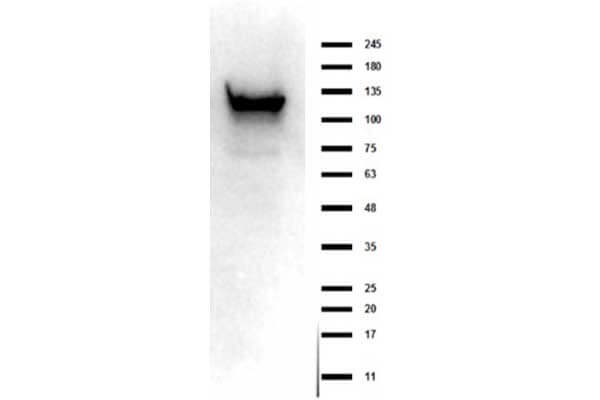Anti-ASAP1 (RABBIT) Antibody
ASAP1 Antibody
- SPECIFICATION
- CITATIONS
- PROTOCOLS
- BACKGROUND

| Host | Rabbit |
|---|---|
| Conjugate | Unconjugated |
| Target Species | Human |
| Reactivity | Human |
| Clonality | Polyclonal |
Application
| WB, E, I, LCI |
| Application Note | Anti-ASAP1 Antibody has been tested for use in ELISA and Western Blot. Expect a band approximately ~125kDa using positive control lysates over-expressing ASAP1, or other specific lysates or tissues. Although not tested, this antibody could be useful in Immunofluorescence or Immunohistochemistry. Specific conditions for reactivity should be optimized by the end user. |
| Physical State | Liquid (sterile filtered) |
| Buffer | 0.02 M Potassium Phosphate, 0.15 M Sodium Chloride, pH 7.2 |
| Immunogen | Anti-ASAP1 affinity purified antibody was prepared from whole rabbit serum produced by repeated immunizations with a synthetic peptide corresponding to the c-terminus region of human ASAP1 protein. |
| Preservative | 0.01% (w/v) Sodium Azide |
| Gene ID | 50807 |
|---|---|
| Other Names | 50807 |
| Purity | This affinity purified antibody is directed against human ASAP1 protein. The product was affinity purified from monospecific antiserum by immunoaffinity purification. A BLAST analysis was used to suggest reactivity to human 100%, bovine 93%, and rat and mouse 87% homology for the immunogen sequence. Cross-reactivity from other sources has not been determined. |
| Storage Condition | Store vial at -20° C prior to opening. Aliquot contents and freeze at -20° C or below for extended storage. Avoid cycles of freezing and thawing. Centrifuge product if not completely clear after standing at room temperature. This product is stable for several weeks at 4° C as an undiluted liquid. Dilute only prior to immediate use. |
| Precautions Note | This product is for research use only and is not intended for therapeutic or diagnostic applications. |
| Name | ASAP1 |
|---|---|
| Synonyms | DDEF1, KIAA1249, PAG2 {ECO:0000303|PubMe |
| Function | Possesses phosphatidylinositol 4,5-bisphosphate-dependent GTPase-activating protein activity for ARF1 (ADP ribosylation factor 1) and ARF5 and a lesser activity towards ARF6. May coordinate membrane trafficking with cell growth or actin cytoskeleton remodeling by binding to both SRC and PIP2. May function as a signal transduction protein involved in the differentiation of fibroblasts into adipocytes and possibly other cell types. Part of the ciliary targeting complex containing Rab11, ASAP1, Rabin8/RAB3IP, RAB11FIP3 and ARF4, which direct preciliary vesicle trafficking to mother centriole and ciliogenesis initiation (PubMed:25673879). |
| Cellular Location | Cytoplasm. Membrane. Golgi apparatus. Golgi apparatus, trans- Golgi network. Note=Predominantly cytoplasmic. Partially membrane-associated. Localized to the Golgi, TGN and rhodopsin transport carriers (RTC) when interacting with RHO in photoreceptors (PubMed:25673879). Localized to RTC when interacting with RAB11A and RAB11FIP3 in photoreceptors (PubMed:25673879) {ECO:0000250, ECO:0000269|PubMed:25673879} |

Thousands of laboratories across the world have published research that depended on the performance of antibodies from Abcepta to advance their research. Check out links to articles that cite our products in major peer-reviewed journals, organized by research category.
info@abcepta.com, and receive a free "I Love Antibodies" mug.
Provided below are standard protocols that you may find useful for product applications.
Background
This antibody is designed, produced, and validated as part of a collaboration between Rockland and the National Cancer Institute (NCI). ASAP1 (ArfGAP with SH3 Domain, Ankyrin Repeat and PH Domain 1) is a Protein Coding gene. This gene encodes an ADP-ribosylation factor (ARF) GTPase-activating protein. The GTPase-activating activity is stimulated by phosphatidylinositol 4,5-biphosphate (PIP2), and is greater towards ARF1 and ARF5, and lesser for ARF6. This gene maybe involved in regulation of membrane trafficking with cell growth or actin cytoskeleton remodeling by binding to both SRC and PIP2. ASAP1 may function as a signal transduction protein involved in the differentiation of fibroblasts into adipocytes and possibly other cell types (By similarity) and plays a role in ciliogenesis. Anti-ASAP1 is useful for researchers interested in GTPase activities and EGFR1 Signaling Pathway.
If you have used an Abcepta product and would like to share how it has performed, please click on the "Submit Review" button and provide the requested information. Our staff will examine and post your review and contact you if needed.
If you have any additional inquiries please email technical services at tech@abcepta.com.













 Foundational characteristics of cancer include proliferation, angiogenesis, migration, evasion of apoptosis, and cellular immortality. Find key markers for these cellular processes and antibodies to detect them.
Foundational characteristics of cancer include proliferation, angiogenesis, migration, evasion of apoptosis, and cellular immortality. Find key markers for these cellular processes and antibodies to detect them. The SUMOplot™ Analysis Program predicts and scores sumoylation sites in your protein. SUMOylation is a post-translational modification involved in various cellular processes, such as nuclear-cytosolic transport, transcriptional regulation, apoptosis, protein stability, response to stress, and progression through the cell cycle.
The SUMOplot™ Analysis Program predicts and scores sumoylation sites in your protein. SUMOylation is a post-translational modification involved in various cellular processes, such as nuclear-cytosolic transport, transcriptional regulation, apoptosis, protein stability, response to stress, and progression through the cell cycle. The Autophagy Receptor Motif Plotter predicts and scores autophagy receptor binding sites in your protein. Identifying proteins connected to this pathway is critical to understanding the role of autophagy in physiological as well as pathological processes such as development, differentiation, neurodegenerative diseases, stress, infection, and cancer.
The Autophagy Receptor Motif Plotter predicts and scores autophagy receptor binding sites in your protein. Identifying proteins connected to this pathway is critical to understanding the role of autophagy in physiological as well as pathological processes such as development, differentiation, neurodegenerative diseases, stress, infection, and cancer.


